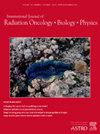缩短辅助光子照射时间以减轻水肿(SAPHIRE)的主要结果分析:低分次区域结节照射 (RNI) 与常规分次区域结节照射 (RNI) 的随机 III 期试验
IF 6.4
1区 医学
Q1 ONCOLOGY
International Journal of Radiation Oncology Biology Physics
Pub Date : 2024-10-01
DOI:10.1016/j.ijrobp.2024.07.007
引用次数: 0
摘要
目的/目标尽管RNI可提高乳腺癌的生存率,但会增加上肢淋巴水肿的风险。材料/方法对建议接受 RNI 治疗的 cT0-T3、N0-N2a、N3a 浸润性乳腺癌患者进行随机分组,选择标准 RNI(STD-RNI:乳房/胸壁 50 Gy,RN 45 Gy)或较短 RNI(SH-RNI:乳房/胸壁 40.05 Gy,RN 37.5 Gy)。根据患者接受化疗的情况、体重指数 (BMI)、腋窝手术类型以及 RNI 前手臂体积的差异对患者进行分层。RN目标包括乳腺内、锁骨下和锁骨上结节基底;如果未进行腋窝淋巴结清扫,则对I级和II级腋窝进行治疗。允许对肿瘤床或胸壁进行刺激。淋巴水肿由主治医生通过标准毒性分级进行评估,并在术前、术后以及放疗后6、12、18和24个月进行连续的周径测量。主要结果的定义是:至少一次放疗后周径评估中手臂体积的相对差异≥10%,并与术前周径测量结果进行归一化。次要结果包括使用 NCI CTCAE 4.0 版量表对医生报告的毒性进行比较,在 RT 期间每周分级一次,6 个月时分级一次,然后每年分级一次。组间比较采用费雪精确检验。采用Kaplan-Meier法计算局部区域复发率(LRR),并采用对数秩检验进行比较。结果从2017年到2022年,共有5个治疗中心的324名患者入组并接受随机治疗,中位随访时间为4.75年。各治疗组的临床病理协变量非常均衡。中位年龄为54岁,64%为非西班牙裔白人,39%的患者体重指数(BMI)为30。57%的患者接受了带或不带重建的乳房切除术,42%的患者接受了分段乳房切除术。68%的患者接受了腋窝淋巴结清扫术,90%的患者接受了化疗。作为主要结果的淋巴水肿测量评估结果,SH-RNI(29%)比 STD-RNI(36%)更少见,但差异无统计学意义(P = 0.24)。相比之下,医生评估的淋巴水肿在 SH-RNI 中明显少于 STD-RNI(15% 对 27%,P = 0.009)。随机接受SH-RNI治疗的患者不太可能出现任何≥2级毒性(52% vs. 78%,P < 0.001)。气管炎并不常见,且组间相似(3% vs 2%,P = 0.46)。没有发生臂丛神经病事件。SH-RNI的五年LRR风险为3%,STD-RNI为2%(P = 0.48)。结论在这项多站点III期随机临床试验的主要结果分析中,SH-RNI并没有降低周径评估淋巴水肿的风险。不过,与 STD-RNI 相比,SH-RNI 的 LRR 风险较低,并降低了医生报告的淋巴水肿风险和 2 级或以上毒性。本文章由计算机程序翻译,如有差异,请以英文原文为准。
Primary Outcome Analysis for Shortening Adjuvant Photon Irradiation to Reduce Edema (SAPHIRE): A Randomized, Phase III Trial of Hypo- vs. Conventionally Fractionated Regional Nodal Irradiation (RNI)
Purpose/Objective(s)
Although RNI improves breast cancer survival, it increases risk of upper extremity lymphedema. We hypothesized that hypofractionated RNI may reduce lymphedema risk.
Materials/Methods
Patients with a recommendation for RNI for cT0-T3, N0-N2a, N3a invasive breast cancer were randomized between standard RNI (STD-RNI: 50 Gy to breast/chest wall and 45 Gy to RN) or shorter RNI (SH-RNI: 40.05 Gy to breast/chest wall and 37.5 Gy to RN). Patients were stratified by receipt of chemotherapy, body mass index (BMI), type of axillary surgery, and difference in arm volume prior to RNI. RN targets included the internal mammary, infraclavicular, and supraclavicular nodal basins; the level I and II axilla was treated if axillary lymph node dissection was not performed. Boost to the tumor bed or chest wall was permitted. Lymphedema was assessed via standard toxicity grading by the treating physician and by serial perometry measurement prior to surgery, post-operatively and then 6, 12, 18, and 24 months after radiation. The primary outcome was defined as a ≥ 10% relative difference in arm volume on at least one post-radiation perometry assessment, normalized by the pre-operative perometry measurement. Secondary outcomes included comparison of physician-reported toxicities using the NCI CTCAE version 4.0 scale graded weekly during RT, at 6 months, and then annually. Fisher’s exact tests compared groups. Local-regional recurrence (LRR) was calculated using the Kaplan-Meier method and compared using the log-rank test.
Results
There were three hundred twenty-four patients across 5 treatment centers were enrolled and randomized from 2017 to 2022 with median follow up of 4.75 years. Clinical-pathologic covariates were well-balanced by treatment arm. Median age was 54 years, 64% were non-Hispanic White, and 39% had body mass index (BMI) > 30. 57% underwent mastectomy with or without reconstruction and 42% underwent segmental mastectomy. Sixty-eight percent underwent axillary lymph node dissection and 90% received chemotherapy. Perometry-assessed lymphedema, the primary outcome, was less common after SH-RNI (29%) than STD-RNI (36%), but the difference was not statistically significant (P = 0.24). In contrast, physician-assessed lymphedema was significantly less common with SH-RNI than STD-RNI (15% vs. 27%, P = 0.009). Patients randomized to SH-RNI were less likely to experience any grade ≥ 2 toxicity (52% vs. 78%, P < 0.001). Pneumonitis was uncommon and similar between groups (3% vs 2%, P = 0.46). There were no brachial plexopathy events. Five-year LRR risk was 3% with SH-RNI and 2% with STD-RNI (P = 0.48).
Conclusion
In this primary outcome analysis of a multisite phase III randomized clinical trial, SH-RNI did not lower risk of perometry-assessed lymphedema. However, SH-RNI conferred a low risk of LRR and reduced the risk of physician-reported lymphedema and grade 2 or higher toxicity when compared to STD-RNI.
求助全文
通过发布文献求助,成功后即可免费获取论文全文。
去求助
来源期刊
CiteScore
11.00
自引率
7.10%
发文量
2538
审稿时长
6.6 weeks
期刊介绍:
International Journal of Radiation Oncology • Biology • Physics (IJROBP), known in the field as the Red Journal, publishes original laboratory and clinical investigations related to radiation oncology, radiation biology, medical physics, and both education and health policy as it relates to the field.
This journal has a particular interest in original contributions of the following types: prospective clinical trials, outcomes research, and large database interrogation. In addition, it seeks reports of high-impact innovations in single or combined modality treatment, tumor sensitization, normal tissue protection (including both precision avoidance and pharmacologic means), brachytherapy, particle irradiation, and cancer imaging. Technical advances related to dosimetry and conformal radiation treatment planning are of interest, as are basic science studies investigating tumor physiology and the molecular biology underlying cancer and normal tissue radiation response.

 求助内容:
求助内容: 应助结果提醒方式:
应助结果提醒方式:


